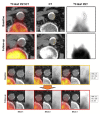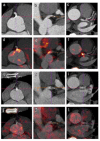NaF-PET Imaging of Atherosclerosis Burden
- PMID: 36826950
- PMCID: PMC9966512
- DOI: 10.3390/jimaging9020031
NaF-PET Imaging of Atherosclerosis Burden
Abstract
The method of 18F-sodium fluoride (NaF) positron emission tomography/computed tomography (PET/CT) of atherosclerosis was introduced 12 years ago. This approach is particularly interesting because it demonstrates microcalcification as an incipient sign of atherosclerosis before the development of arterial wall macrocalcification detectable by CT. However, this method has not yet found its place in the clinical routine. The more exact association between NaF uptake and future arterial calcification is not fully understood, and it remains unclear to what extent NaF-PET may replace or significantly improve clinical cardiovascular risk scoring. The first 10 years of publications in the field were characterized by heterogeneity at multiple levels, and it is not clear how the method may contribute to triage and management of patients with atherosclerosis, including monitoring effects of anti-atherosclerosis intervention. The present review summarizes findings from the recent 2¾ years including the ability of NaF-PET imaging to assess disease progress and evaluate response to treatment. Despite valuable new information, pertinent questions remain unanswered, not least due to a pronounced lack of standardization within the field and of well-designed long-term studies illuminating the natural history of atherosclerosis and effects of intervention.
Keywords: 18F-sodium fluoride; NaF; PET/CT; atherosclerosis; disease progression; intervention.
Conflict of interest statement
The authors declare no conflict of interest.
Figures





References
-
- Zhuang X., Feng Y., Li J., Zhao F., Zhang Y., Chen Y. A longitudinal 18F-fluorodeoxyglucose (18F-FDG) and 18F-sodium fluoride (18F-NaF) positron emission tomography/computed tomography (PET/CT) study in apolipoprotein E (ApoE) knockout rats fed with a Western diet. Cardiovasc. Diagn. Ther. 2021;11:39–49. doi: 10.21037/cdt-20-609. - DOI - PMC - PubMed
Publication types
LinkOut - more resources
Full Text Sources

